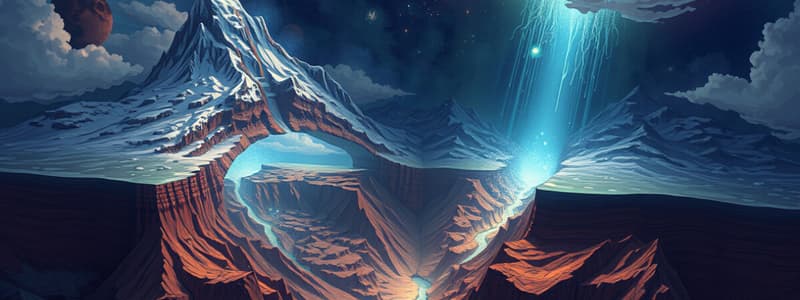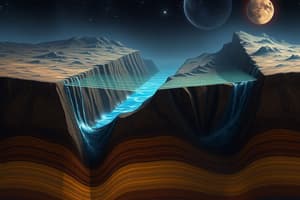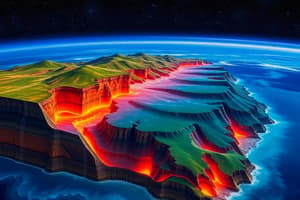Podcast
Questions and Answers
Divergent boundaries are characterized by tectonic plates moving towards each other.
Divergent boundaries are characterized by tectonic plates moving towards each other.
False (B)
Subduction zones are commonly found at divergent boundaries.
Subduction zones are commonly found at divergent boundaries.
False (B)
Transform boundaries are associated with the formation of new oceanic crust.
Transform boundaries are associated with the formation of new oceanic crust.
False (B)
The movement of tectonic plates is primarily driven by convection currents in the Earth's mantle.
The movement of tectonic plates is primarily driven by convection currents in the Earth's mantle.
Oceanic-continental convergence can lead to the formation of mountain ranges.
Oceanic-continental convergence can lead to the formation of mountain ranges.
Shield volcanoes have a steep and narrow structure.
Shield volcanoes have a steep and narrow structure.
Ridge push is a mechanism that helps to pull tectonic plates apart.
Ridge push is a mechanism that helps to pull tectonic plates apart.
Earthquakes are less common at plate boundaries compared to other locations.
Earthquakes are less common at plate boundaries compared to other locations.
Study Notes
Types of Plate Boundaries
-
Divergent Boundaries
- Plates move apart.
- New oceanic crust forms (e.g., mid-ocean ridges).
- Associated with volcanic activity and earthquakes.
-
Convergent Boundaries
- Plates collide or move towards each other.
- Can form mountains, trenches, or volcanic arcs.
- Types:
- Oceanic-Continental: Oceanic plate subducts beneath continental plate (e.g., Andes).
- Oceanic-Oceanic: One oceanic plate subducts beneath another (e.g., Japan).
- Continental-Continental: Plates collide to form mountain ranges (e.g., Himalayas).
-
Transform Boundaries
- Plates slide past each other horizontally.
- Characterized by strike-slip faults (e.g., San Andreas Fault).
- Can cause significant earthquakes.
Subduction Zones
- Areas where one tectonic plate is forced under another.
- Commonly found at convergent boundaries.
- Features include:
- Deep ocean trenches (e.g., Mariana Trench).
- Volcanic arcs formed by melting subducted plate material.
- Associated with intense seismic activity and can lead to powerful earthquakes.
Tectonic Plate Movement
- Movement driven by convection currents in the Earth's mantle.
- Plates can move at rates of a few centimeters per year.
- Types of movements:
- Ridge Push: Gravity causes the elevated mid-ocean ridges to push plates apart.
- Slab Pull: Denser oceanic plates subduct, pulling the rest of the plate down.
- Mantle Drag: Motion of the mantle can drag plates along.
Earthquakes and Volcanoes
-
Earthquakes
- Occur due to stress accumulation along faults and subsequent release.
- Magnitude and intensity depend on the energy released.
- Most common at plate boundaries, especially transform and convergent zones.
-
Volcanoes
- Form primarily at divergent and convergent boundaries.
- Types include:
- Shield Volcanoes: Broad, gentle slopes (e.g., Mauna Loa).
- Stratovolcanoes: Steep, layered structure (e.g., Mount St. Helens).
- Cinder Cone: Small, steep-sided (e.g., Paricutin).
-
Eruptions can vary from effusive (lava flows) to explosive (ash and pyroclastic flow).
Types of Plate Boundaries
- Divergent boundaries occur when tectonic plates move apart, resulting in the formation of new oceanic crust, notably at mid-ocean ridges, where volcanic activity and earthquakes are common.
- Convergent boundaries involve plates colliding or moving toward each other, leading to the formation of mountains, oceanic trenches, or volcanic arcs, with three types categorized by the plates involved:
- Oceanic-Continental: The oceanic plate subducts beneath the continental plate, exemplified by the Andes mountain range.
- Oceanic-Oceanic: One oceanic plate subducts beneath another, as seen in Japan.
- Continental-Continental: Plates collide to create mountain ranges like the Himalayas.
- Transform boundaries form when plates slide horizontally past one another, characterized by strike-slip faults such as the San Andreas Fault, which can lead to significant earthquakes.
Subduction Zones
- Subduction zones are regions where one tectonic plate is forced beneath another, primarily located at convergent boundaries.
- They feature deep ocean trenches, such as the Mariana Trench, and volcanic arcs resulting from the melting of subducted plate material.
- These zones are associated with intense seismic activity, often leading to powerful earthquakes.
Tectonic Plate Movement
- Tectonic plate movement is driven by convection currents in the Earth's mantle, with plates migrating at rates of a few centimeters annually.
- Movement types include:
- Ridge Push: Elevated mid-ocean ridges exert gravitational pull, pushing plates apart.
- Slab Pull: Denser oceanic plates subduct, pulling the rest of the plate downward.
- Mantle Drag: The motion of the mantle can further drag plates along.
Earthquakes and Volcanoes
- Earthquakes result from stress accumulation along faults and their subsequent release, with magnitude and intensity determined by the energy released. They are most prevalent at plate boundaries, especially in transform and convergent zones.
- Volcanoes predominantly form at divergent and convergent boundaries, with three main types:
- Shield Volcanoes: Have broad, gently sloping shapes, like Mauna Loa.
- Stratovolcanoes: Exhibit steep, layered structures, such as Mount St. Helens.
- Cinder Cone: Small and steep-sided, exemplified by Paricutin.
- Volcanic eruptions can be effusive, characterized by flowing lava, or explosive, producing ash and pyroclastic flows.
Studying That Suits You
Use AI to generate personalized quizzes and flashcards to suit your learning preferences.
Description
This quiz explores the types of plate boundaries including divergent, convergent, and transform boundaries, and delves into subduction zones. Students will learn about the geological features and processes associated with each type, including examples from around the world. Perfect for earth science enthusiasts!




